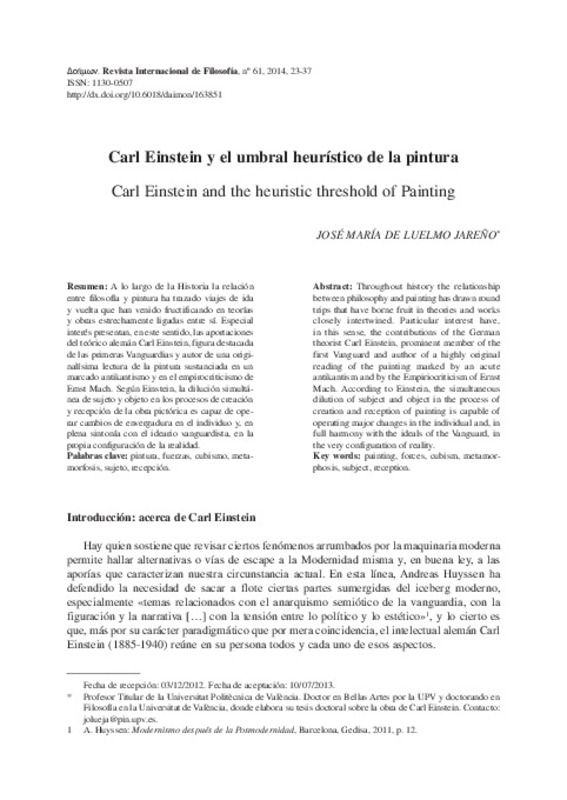JavaScript is disabled for your browser. Some features of this site may not work without it.
Buscar en RiuNet
Listar
Mi cuenta
Estadísticas
Ayuda RiuNet
Admin. UPV
CARL EINSTEIN Y EL UMBRAL HEURÍSTICO DE LA PINTURA
Mostrar el registro sencillo del ítem
Ficheros en el ítem
| dc.contributor.author | Luelmo Jareño, Jose Mª de
|
es_ES |
| dc.date.accessioned | 2015-06-02T08:50:05Z | |
| dc.date.available | 2015-06-02T08:50:05Z | |
| dc.date.issued | 2014-01 | |
| dc.identifier.issn | 1130-0507 | |
| dc.identifier.uri | http://hdl.handle.net/10251/51103 | |
| dc.description.abstract | [EN] Throughout history the relationship between philosophy and painting has drawn round trips that have borne fruit in theories and works closely intertwined. Particular interest have, in this sense, the contributions of the German theorist Carl Einstein, prominent member of the first Vanguard and author of a highly original reading of the painting marked by an acute antikantism and by the Empiriocriticism of Ernst Mach. According to Einstein, the simultaneous dilution of subject and object in the process of creation and reception of painting is capable of operating major changes in the individual and, in full harmony with the ideals of the Vanguard, in the very configuration of reality | es_ES |
| dc.description.abstract | [ES] A lo largo de la Historia la relación entre filosofía y pintura ha trazado viajes de ida y vuelta que han venido fructificando en teorías y obras estrechamente ligadas entre sí. Especial interés presentan, en este sentido, las aportaciones del teórico alemán Carl Einstein, figura destacada de las primeras Vanguardias y autor de una originalísima lectura de la pintura sustanciada en un marcado antikantismo y en el empirocriticismo de Ernst Mach. Según Einstein, la dilución simultánea de sujeto y objeto en los procesos de creación y recepción de la obra pictórica es capaz de operar cambios de envergadura en el individuo y, en plena sintonía con el ideario vanguardista, en la propia configuración de la realidad. | es_ES |
| dc.language | Español | es_ES |
| dc.publisher | Universidad de Murcia | es_ES |
| dc.relation.ispartof | Daimon | es_ES |
| dc.rights | Reconocimiento - No comercial - Sin obra derivada (by-nc-nd) | es_ES |
| dc.subject | Painting | es_ES |
| dc.subject | Forces | es_ES |
| dc.subject | Cubism | es_ES |
| dc.subject | Metamorphosis | es_ES |
| dc.subject | Subject | es_ES |
| dc.subject | Reception | es_ES |
| dc.subject | Pintura | es_ES |
| dc.subject | Fuerzas | es_ES |
| dc.subject | Cubismo | es_ES |
| dc.subject | Metamorfosis | es_ES |
| dc.subject | Sujeto | es_ES |
| dc.subject | Recepción | es_ES |
| dc.subject.classification | PINTURA | es_ES |
| dc.title | CARL EINSTEIN Y EL UMBRAL HEURÍSTICO DE LA PINTURA | es_ES |
| dc.type | Artículo | es_ES |
| dc.identifier.doi | 10.6018/daimon/163851 | |
| dc.rights.accessRights | Abierto | es_ES |
| dc.contributor.affiliation | Universitat Politècnica de València. Departamento de Pintura - Departament de Pintura | es_ES |
| dc.description.bibliographicCitation | Luelmo Jareño, JMD. (2014). CARL EINSTEIN Y EL UMBRAL HEURÍSTICO DE LA PINTURA. Daimon. (61):23-37. doi:10.6018/daimon/163851 | es_ES |
| dc.description.accrualMethod | S | es_ES |
| dc.relation.publisherversion | http://dx.doi.org/10.6018/daimon/163851 | es_ES |
| dc.description.upvformatpinicio | 23 | es_ES |
| dc.description.upvformatpfin | 37 | es_ES |
| dc.type.version | info:eu-repo/semantics/publishedVersion | es_ES |
| dc.description.issue | 61 | es_ES |
| dc.relation.senia | 259427 | |
| dc.identifier.eissn | 1989-4651 |








